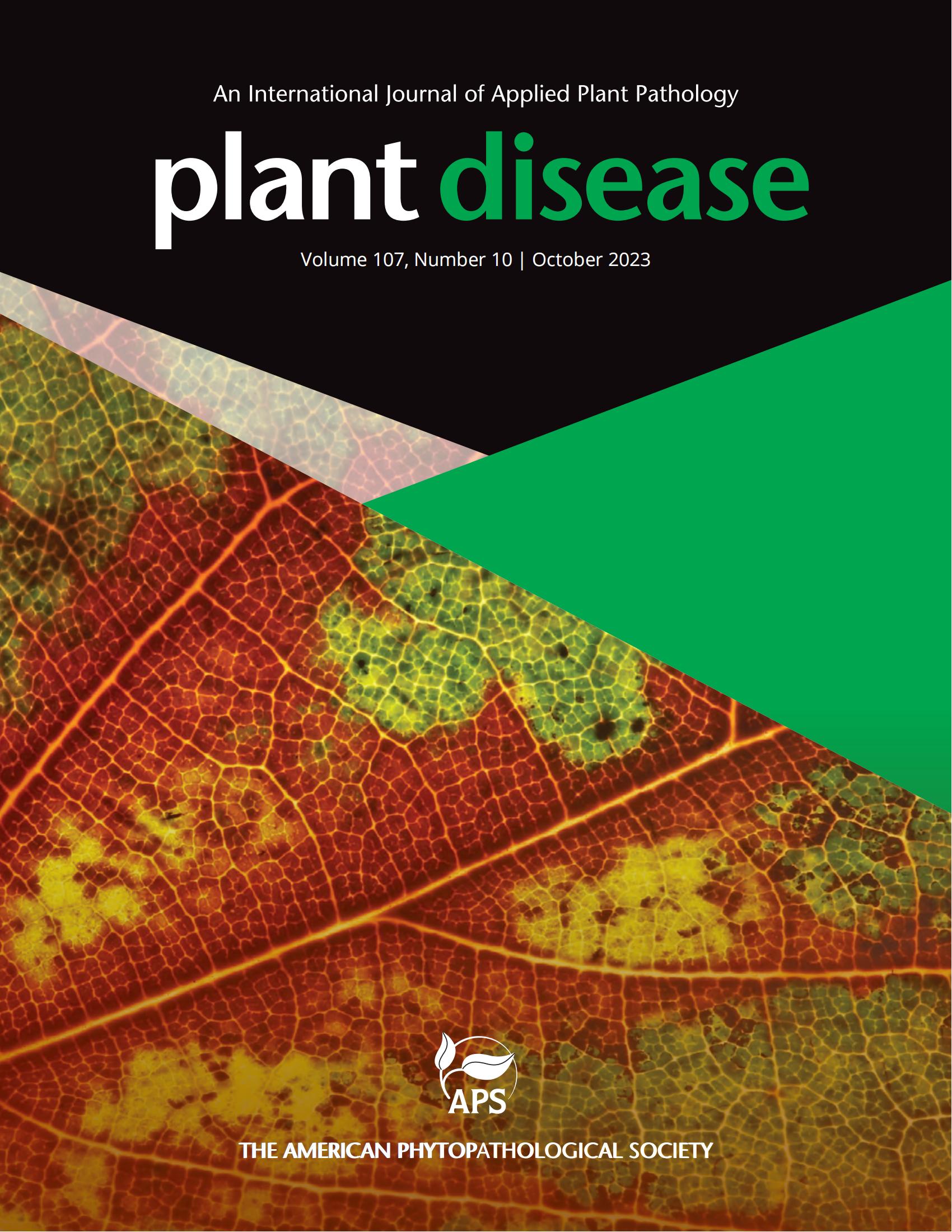中国首次报道由准姜黄色肠杆菌引起的生姜细菌性叶斑病。
摘要
2023 年秋季,中国南宁市邕宁区(22°49'N; 108°48'E)两块约 1800 平方米的生姜(Zingiber officinale Roscoe)发生了一种未知叶斑病,发病率为 20-30%。症状开始是叶片上出现黄色斑点,然后扩大为椭圆形至不规则形病斑,病斑边缘呈黄色,在干燥天气下,病斑中部变为灰白色。最后,多个病斑导致整个叶片坏死。从两块田地的 6 株植物上采集了 12 片病叶,进行表面消毒后磨碎。磨碎的样品稀释后在营养琼脂(NA)培养基上培养 48-72 小时,纯化的菌落呈乳白色,圆形,边缘光滑。选取了三个分离菌株(GL1、GL2 和 GL3)进行鉴定和致病性测定。它们均为革兰氏阴性,能利用山梨醇、甘露醇、肌醇、棉子糖、三聚糖、双糖和柠檬酸盐;甲基红、苯丙氨酸脱羧酶、硫化氢、脲酶均为阴性;伏格-普罗斯考尔试验和鸟氨酸脱羧酶均为阳性。这些特征与肠杆菌属一致(Wu 等人,2020 年)。从三个分离株中提取了基因组 DNA。使用 27F/1492R 引物(Weisburg 等,1991 年)扩增了 16S rDNA 区域并进行了测序(登录号:PP837703-PP837705)。Blastn 分析表明,GL1 的 16S rDNA 序列与肠杆菌 quasiroggenkampii WCHECL1060 (NR_179166) 的相同度分别为 99% (1373/1387 nt)、96% (1364/1422 nt) 和 95% (1365/1435 nt)。为了确定物种,分别使用引物 gyrB 01-F/gyrB 02-R、rpoB CM7/rpoB CM31b 和 atpD 01-F/atpD 02-R 扩增了 gyrB、rpoB 和 atpD 基因的序列(Lin 等,2015 年;Zhu 等,2010 年;Zhang 等,2013 年)。这些序列的GenBank登录号为PP857680-PP857688。在 MEGA6 软件中使用邻接法(NJ)和 1000 次引导重复,用 16S rDNA-gyrB-rpoB-atpD 的序列连接构建了多焦点系统发生树。这三个分离物与 E. quasiroggenkampii 聚类。对 15 株处于 4-5 叶期的 Darou 生姜品种进行了致病性测试。用直径为 0.36 毫米的注射器针头刺破每株生姜的两到三片叶子,然后喷洒细菌悬浮液(108 CFU/mL)进行接种,无菌水作为对照。每种分离物接种 5 株植物,重复试验 3 次。接种 3-4 天后,所有受伤的叶片和大约 10% 未受伤的叶片都出现了与田间观察到的症状相似的症状。对照植物没有出现症状。从出现症状的接种叶片中再次分离出准根康比肠杆菌,并通过 gyrB 测序和菌落形态确认了它们的身份,从而完成了科赫假说。准罗根坎皮氏肠杆菌是一种人类病原体,可引起医院内感染(Wu 等,2020 年)。在广西,E. quasiroggenkampii 被确定为导致桑枯萎病的病原体之一(Jiao,2022 年)。据我们所知,这是首次报道 E. quasiroggenkampii 导致生姜细菌性叶斑病。该研究结果不仅对生姜叶斑病的防治具有现实意义,而且可为研究肠杆菌属的分化和致病机理提供极好的材料,具有重要的学术价值。In autumn 2023, an unknown leaf spot disease has occurred on ginger (Zingiber officinale Roscoe) in two fields of approximately 1800 m2 in Yongning District (22°49'N; 108°48'E), Nanning, China, with a incidence of 20-30%. The symptoms began as yellow spots on the leaves, expanding into elliptical to irregular lesions with yellow edges, the middle of the lesion turning grey-white in dry weather. Finally, multiple spots caused necrosis of the whole leaf. Twelve diseased leaves from six plants of two fields were collected, surface disinfected and ground. The ground samples were diluted and plated on nutrient agar (NA) medium at 28 °C for 48-72 h. The purified colonies appeared milky white and round, with smooth edges. Three isolates (GL1, GL2 and GL3) were selected for identification and pathogenic determination. They were gram negative, could utilize sorbitol, mannitol, inositol, raffinose, melibiose, disaccharides, and citrate; negative for methyl red, phenylalanine decarboxylase, hydrogen sulfide, urease; positive for voges-proskauer test and ornithine decarboxylase. These characteristics were consistent with Enterobacter genus (Wu et al., 2020). Genomic DNA was extracted from three isolates. The 16S rDNA region was amplified using 27F/1492R primers (Weisburg et al. 1991) and sequenced (accession no. PP837703-PP837705). Blastn analysis revealed that 16S rDNA sequences for GL1 was 99% identical (1373/1387 nt), GL2 96% (1364/1422 nt) and GL3 95% (1365/1435 nt) to Enterobacter quasiroggenkampii WCHECL1060 (NR_179166). To determine the species, the sequences of gyrB, rpoB and atpD genes were amplified using primers gyrB 01-F/gyrB 02-R, rpoB CM7/rpoB CM31b, and atpD 01-F/atpD 02-R, respectively (Lin et al. 2015; Zhu at al. 2010; Zhang et al. 2013). The GenBank accession numbers for the sequences were PP857680-PP857688. A multilocus phylogenetic tree was constructed with the concatenated sequence of 16S rDNA-gyrB-rpoB-atpD by using the Neighbor-Joining (NJ) method with 1000 bootstrap replicates in MEGA6 software. The three isolates clustered with E. quasiroggenkampii. Fifteen Darou ginger variety plants at the 4-5 leaf stage were tested for pathogenicity. Two to three leaves of each ginger plant were pricked with a syringe needle of 0.36mm in diameter or not and inoculated by spraying the bacterial suspension (108 CFU/mL), sterile water was used as a control. Five plants were inoculated with each isolate and the test was repeated three times. After 3-4 days of inoculation, all wounded leaves and about 10% of the unwounded leaves showed symptoms similar to those observed in the field. Control plants did not develop symptoms. Enterobacter quasiroggenkampii isolates were re-isolated from the inoculated leaves with symptoms, and their identity was confirmed by gyrB sequencing and colony morphology, completing Koch's postulates. Enterobacter quasiroggenkampii is a pathogen of humans that can cause nosocomial infections (Wu et al., 2020). In Guangxi, E. quasiroggenkampii was identified as one of the pathogens causing mulberry wilt (Jiao, 2022). To our knowledge, this is the first report of E. quasiroggenkampii causing bacterial leaf spot disease of ginger. The results of this study not only have practical significance for the control of ginger leaf spot, but also can provide excellent materials for the study of the differentiation and pathogenic mechanism of the genus Enterobacter, which has important academic value.

 求助内容:
求助内容: 应助结果提醒方式:
应助结果提醒方式:


